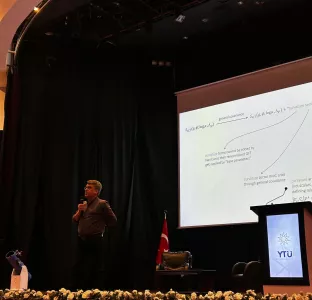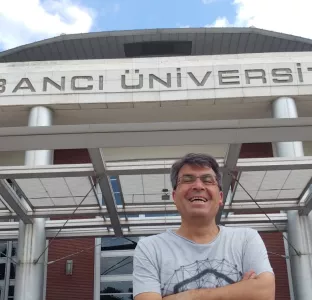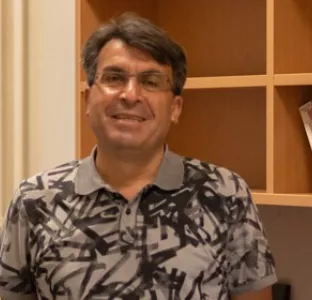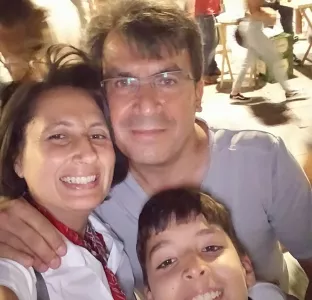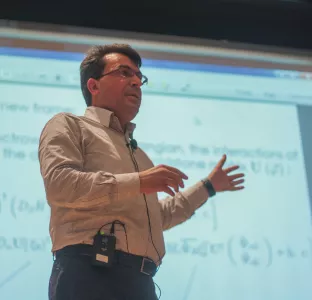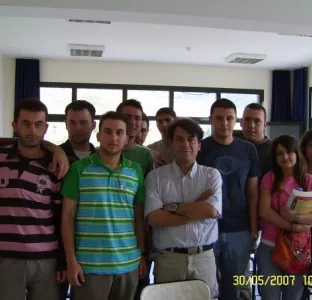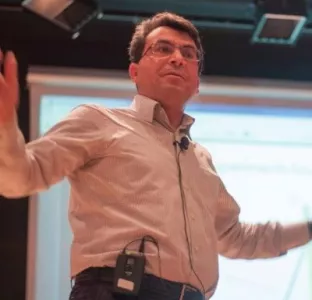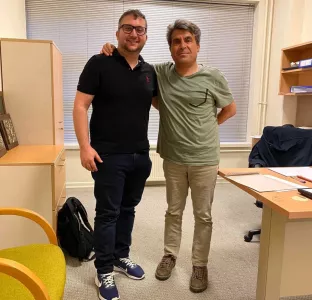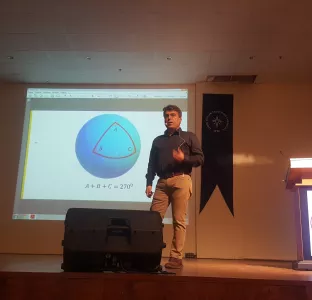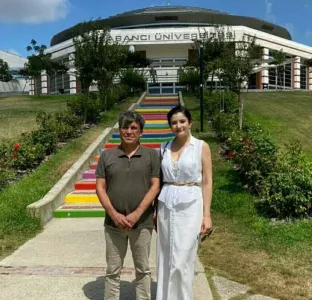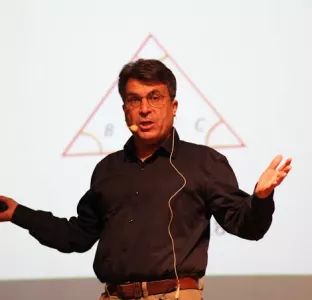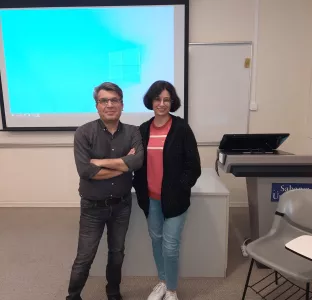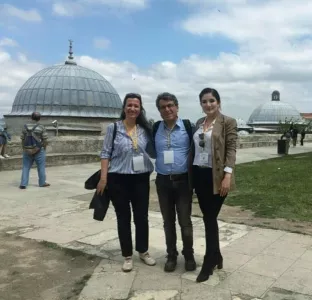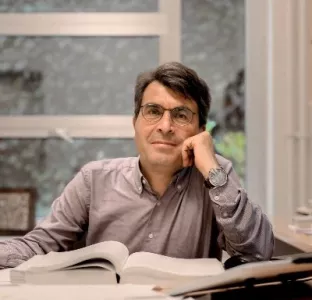Newsletter - Issue 8
Memorial Issue Dedicated to Prof. Dr. Durmuş Ali Demir
Newsletter - Issue 8
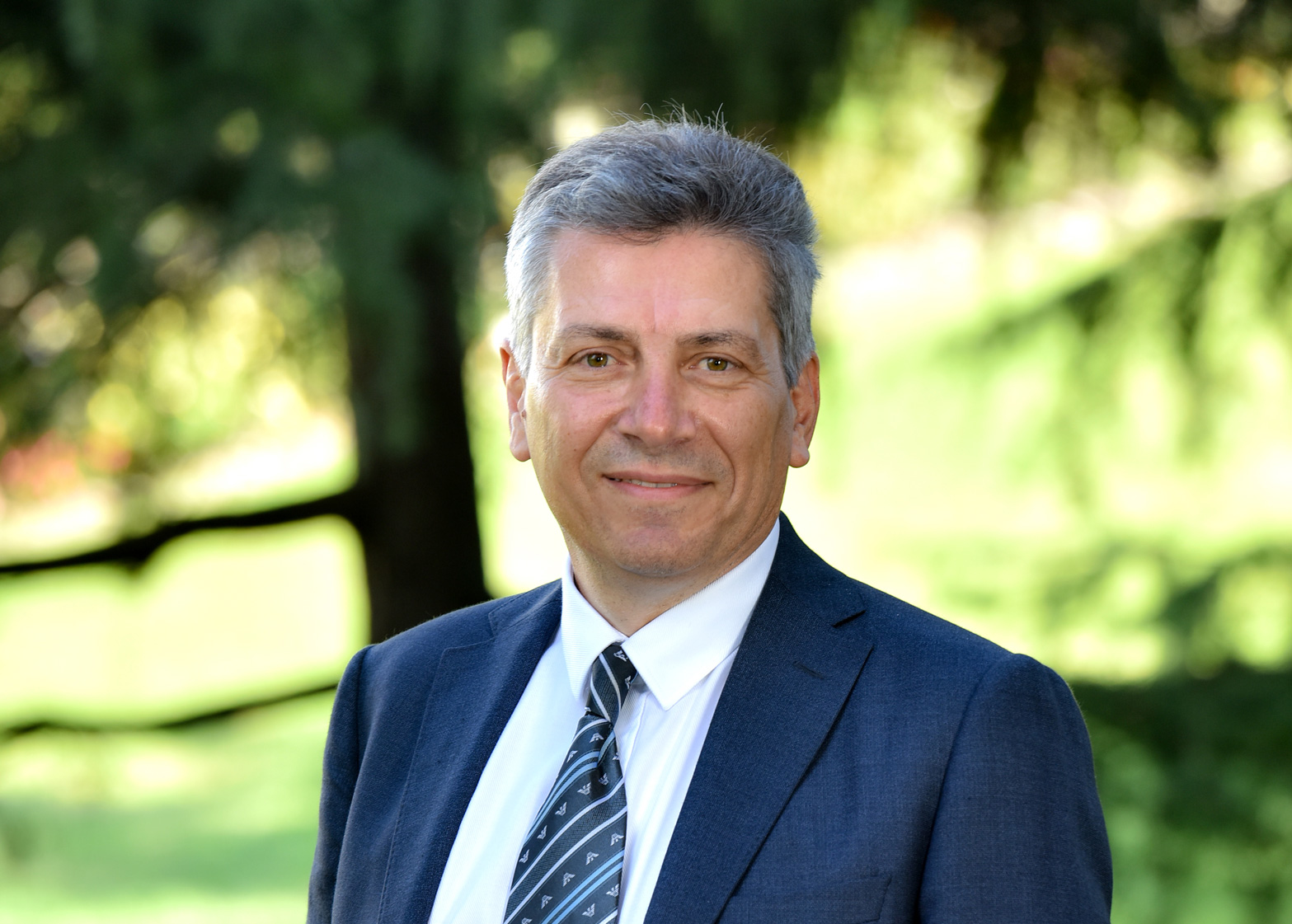
Dear Students, Friends, and Colleagues,
It is my privilege and honor to present the new edition of the FENS Newsletter, dedicated to our esteemed faculty member, Professor Durmuş Ali Demir. His sudden passing on February 24th, 2024, has left a significant void in our hearts and the academic community at large.
Professor Durmuş Ali Demir is a colleague, a good friend, an internationally renowned Scientist, and a cherished teacher whose impact reached far beyond the classroom. Celebrated for his dedication to education and unwavering commitment to his students, Durmuş Ali Hoca touched the lives of countless individuals throughout his distinguished academic career. He was a role model for everyone—as a scientist, teacher, colleague, father, and friend.
In this issue of the newsletter, we have compiled his short biography, a list of the courses he taught, how his colleagues describe him, messages after his passing, a brief description of his research interest, how he describes his own research, content from his media presence, a gallery of pictures and a link to the Commemoration Ceremony video. You can also access a webpage dedicated to his memory.
His legacy and impact will always be remembered by Sabancı University and the scientific community.
Best regards,
Erkay Savaş
1967 - 2024
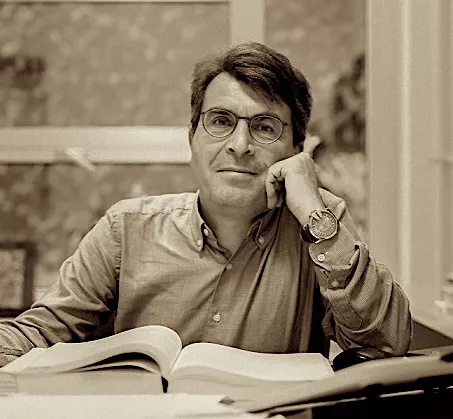
Prof. Dr. Durmuş Ali Demir completed his undergraduate studies in the Department of Electrical and Electronics Engineering at Middle East Technical University from 1987 to 1991. During this time, he concurrently earned a Minor Degree in Physics from 1988 to 1991. Subsequently, he obtained his master's degree in 1993 and completed his doctoral studies in 1995, both in the Department of Physics at Middle East Technical University.
Between 1996-1997, 1998-2000, and 2000-2003, Prof. Dr. Durmuş Ali Demir held postdoctoral researcher positions in three different institutions: the University of Pennsylvania, Abdus Salam International Centre for Theoretical Physics, and William I. Fine Theoretical Physics Institute at the University of Minnesota, respectively. Subsequently, Prof. Dr. Durmuş Ali Demir worked as a faculty member at İzmir Institute of Technology from 2003 to 2019. Since 2019, he has been a faculty member at Sabancı University.
Prof. Dr. Durmuş Ali Demir worked at the DESY research center in Hamburg between 2007 and 2008, having received the Alexander von Humboldt Foundation Friedrich Wilhelm Bessel Research Award. Among other significant awards he has received are the TÜBİTAK Incentive Award (2005), TÜBA GEBIP Award (2004), Mustafa N. Parlar Foundation Research Incentive Award (1997), and Sedat Simavi Science Award (2001).
Prof. Dr. Durmuş Ali Demir was one of the editors of the LHEP Journal. In 2020, he was included among the 'Most Influential Scientists in the World.' Additionally, he was a member of the World Academy of Sciences and he was on the executive board of the Science Academy.
Prof. Dr. Durmuş Ali Demir is among the world's leading theoretical physicists. His research interests were particle physics, astroparticle physics and quantum physics. His research subjects were focused on the effects of quantum fields at low energies (quantum tunneling) and high energies (fifth force and emergent gravity).
At Sabancı University, Prof. Dr. Durmuş Ali Demir taught a variety of courses, including the following:
PHYS 211 - Modern Physics
PHYS 401/501 - Classical Mechanic
PHYS 411/511 - Electromagnetic Theory I
ENS 525 - Mathematical Methods for Scientists and Engineers I
PHYS 617 - Quantum Field Theory I
NS 101 - Science of Nature I
NS 102 - Science of Nature II
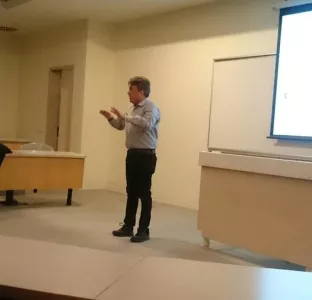
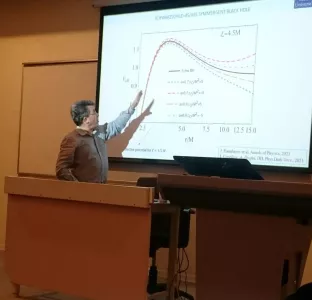


Durmuş Ali Demir ODTÜ Fizik Bölümünde yüksek lisans ve doktora öğrencilerine verdiğim İstatistik Fizik dersini alan öğrenciler arasındaydı. Sonra meslektaş olduğumuzda, Sabancı Üniversitesinde ve Bilim Akademisinde birlikte çalışırken Durmuş'u ayıran özelliklerini yakından gördüm. Saf, temiz, olağanüstü zeki, heyecanlı, yaratıcı ve kendini tamamen fiziğe vermiş bir değerli insandı. Çalışkanlıktan öte, kendini sevinçle, tutkuyla yaptığı işe, bilime adamıştı.
Durmuş Hocam bitmeyen heyecanıyla, eşsiz nezaketi ve alçakgönüllülüğü ile ilk tanıştığım günden beri beni etkilemiş bir bilim insanı ve çalışma arkadaşıydı. Yemekten dönerken odanıza uğrayıp ettiğimiz sohbetleri özlüyorum, özleyeceğim. Tekrardan başımız sağolsun.
Durmuş Ali Demir Hocam’ın ardından,
Profesör Durmuş Ali Demir, dünyanın en saygın teorik fizikçilerinden biri, bir entelektüel, bir öğretmendi. Ben onun öğrencisiyim. Tüm bu vasıfları ile hayatımdaki etkisi büyüktür. Güzel bir bilim insanı, hayat boyu mentor ve güzel bir dost idi.
Profesör Demir, öğrencilerine her zaman en doğru yolu göstermek için çaba harcayan bir öğretmen olmuştur. Birçok yüksek lisans ve doktora öğrencisi yetiştirmiştir; donanımlı birer araştırmacı olabilmeleri için çaba harcamıştır. Benim İYTE’de doktora tez hocamdı. Tezimi çalışırken literature yeni, öncü fikirler sunabilmenin nasıl bir heyecan olduğunu, bir tezin nasıl olması gerektiğini kendisiyle çalışarak deneyimledim. Kendisi kuantum alan kuramı, kuantum mekaniği ve genel relativite derslerini sıra dışı bir anlaşılırlıkla verebilen nadir kişilerdendi. Kendisiyle parçacık fiziği modelleme çalışmalarından emergent kütle çekim çalışmalarına uzanan değişik konularda çalışmalar yürüttüm. Kendisiyle çalıştığım her an bilgisinin, algısının derinliğini her seferinde tecrübe ettim. Kendisinin araştırmacılığım ve mentörlüğüm üzerindeki etkisi büyüktür.
Profesör Demir, Sabancı Üniversite'sinde çalıştığı yıllarda, çoğunlukla hafta sonu da dahil olmak üzere her gün mutlaka ofisine gelirdi. Kendisiyle Sabancı Üniversitesi’nde son güne kadar beraber çalışmaya devam ettim. Her gün mutlaka sistemli olarak görüşür interaktif çalışırdık, yurtiçi ve yurtdışı iş birliklerini yönetirdik. Kendisi sıra dışı yaratıcılığı ve derin bilgisiyle bu çalışmalar sırasında benim araştırmacı ve mentörlük yönüme çok büyük katkılarda bulunmuştur. Her zaman çalışma planlarına sadık kalmaya özen gösterirdi, “bir işin bitmesi gerekiyorsa, gerekirse sabaha kadar uyumayız” derdi. Yaptığı her şey sahici idi; kendisine duyduğum sonsuz saygı ve sevgiyle beraber, her gün bu çalışma temposuyla, hevesle çalışmaya devam ettim. Hocamla içinde olduğumuz birçok ulusal ve uluslararası iş birliklerimiz, projelerimiz, yetişen doktora öğrencisi bulunmaktadır. En yakınındaki kişi olarak, bu işlerin hepsinin içindeki biri olarak Hocamla beraber yaptığımız her işi kendisine her daim saygı ve sevgi duyarak yürütmek vazifemdir.
Son zamanına kadar hep tutkuyla, kendisinin temel yapısını attığı ve de ayrıca beraber de kurduğumuz alanında öncü, temel çalışmalar oldu; bunlar “Symmergent Kütleçekim kuramı” ve “Geometrik beşinci kuvvet” olmak üzere iki ana çalışma alanıydı ve birebir son zamana kadar beraber çalışma şansını yakaladım. Profesör Demir, “Symmergent Kütleçekim kuramı”’nda özgün ve tamamıyla kendisine ait olan, “kuantum alan kuramı”’ndan kütle çekimin Higgs mekanizmasına benzer bir şekilde zuhur ettiğini göstermiştir ve zamanımızın teorik fiziğinin kökten yapısal katkıya ihtiyaç duyduğu bu dönemde çok önemli bir yaklaşım sunmuştur. “Geometrik beşinci kuvvet” ise bir diğer dışarıya açıldığımız, literature yine ilk olarak beraber sunma şansını yakaladığım öncü bir yaklaşımdır.
Entelektüel biri idi, bilimden tarihe birçok konu konuşurduk. Aklımda yer eden anlarımızdan biri, eski Yunan’da olan bir durumdan bahsetmesiydi. Demişti ki, “eski Yunan’da, ölen kişi için “tutkusu neydi?” diye sorarlarmış, Beyhan”. Çok etkilenmiştim, tutkunun bir nevi timsali zaten karşımda duruyordu. Hayatı ve söyledikleri her zaman müsemma idi.
Profesör Demir’in temel bilimsel yaklaşımı, Türkiye’den her zaman özgün ve öncü çalışmalar sunabilmekti; derdi ki “Beyhan, dışarıdaki çalışmalara katılmak değildir mesele, mesele bizim buradan Türkiye’den yeni, özgün kendi fikrimizle dışarıya açılmamızdır ve biz bunu yapmaya çalışıyoruz, yaptığımız bu”. Bu benim koşulsuz benimsediğim bir yaklaşımdır ve saygıdeğer hocamın gösterdiği yolda devam etmek benim için bir onur olacaktır.
Öğrenciniz sizi her zaman sonsuz sevgi, saygı ve özlemle anacak sevgili Hocam.
Mayıs 2024
Beyhan Puliçe
Sabancı Üniversitesi
Durmuş Hoca'mızı 24 Şubat 2024 tarihinde aniden kaybettik. Hocamız, Sabancı Üniversitesi'nde bir öğretim üyesi olmadan önce de birçoğumuza dokunmuştu, mesela Ali (Alpar) hocanın öğrencisi, ODTÜ Fizik Bölümü'ne yeni başlamış benim ise ilk asistanımdı. Daha o zamanlar bir yıldızdı, Fizik Bölümü'ndeki hocalar Durmuş'tan çok büyük övgüyle bahsederlerdi. Sonraki yolculuğunda, Minnesota, Trieste, İzmir Yüksek Teknoloji Enstitüsü, bu başarıları üstüne koyarak devam ettirdi, yıldız parlamaya devam etti, ta ki belki de en parlak olduğu dönemde aniden sönene dek. Durmuş, sadece başarılı bir fizikçi değil, son derece mütevazi, son derece saf, çok iyi de bir insandı. Çalışkanlığı ve azmi ile birçok öğrenciye örnek oldu. Hepimiz onu arıyoruz ve özlüyoruz...
İsmail Turan
Middle East Technical University, Department of Physics
In ancient Greece, they wouldn't write obituaries for the deceased; instead, when laying them to rest, they would simply ask, "What was their passion in life?" This was a story that our beloved Durmuş Ali Demir occasionally shared with his students, and it seems he had made it a motto to live for a purpose in this life. As I navigate through these days of shock and profound sorrow, I find myself oscillating between the difficulty of writing about Durmuş Hoca and the necessity of saying much more about him. In this piece, I will discuss a topic that I believe would bring him joy: his passion in life. I also aim to include glimpses of his life, as I believe there are lessons to be drawn from it.
Durmuş Ali Demir was born in 1969 in a Yörük village in Silifke, amidst an unfortunate incident where his two-year-old brother passed away. He was given his brother's identity and seemed to have started life two years ahead of himself. Under such circumstances, no one could have imagined that someone starting life like this would later take on missions of advancing in the scientific world and becoming a pioneer. He once mentioned a physics professor who was also his father, saying, "His father wasn't an ordinary person like ours," as if forgetting that the real success story lay within himself.
Durmuş Hoca attended the Meteorology Technical High School in Ankara as a boarder due to compulsory service and graduated in 1986. He later attended the Electrical and Electronics Department at the Middle East Technical University (METU), where he would also serve his compulsory service by doing shifts at the General Directorate of Meteorology. While I do not know much about his earlier years, we know that his love for physics blossomed during his university years, as he pursued a minor in physics while studying engineering at METU. During those years, his physics professors, Metin Durgut and the late Namık Kemal
Pak, played a significant role in shaping his academic life. He managed to complete both his master's and doctoral programs in about four years and authored nearly 10 papers. One of the biggest factors behind this achievement was Durmuş Hoca's boundless energy and his almost 24/7 work ethic. In the later years, Namık Hoca would often refer to Durmuş Hoca as an example to me and other students, his eyes sparkling whenever he talked about him. During the years of his doctoral studies, Namık Hoca was working at TÜBİTAK (The Scientific and Technological Research Council of Turkey), and Durmuş Hoca had conducted most of his doctoral studies with dear T. M. Aliev. He used to talk about Aliev Hoca as his doctoral advisor, always acknowledging Namık Hoca's role and giving credit where it was due. From what I observed, he had a very special relationship with both of them, and they held a significant place in his life. I witnessed their affection for each other on numerous occasions. When we bid farewell to Namık Hoca for the last time on November 10, 2015, in Ankara, I couldn't understand Durmuş Hoca's feelings. I could see that he was facing his beloved teacher's loss with great composure. Later, I learned that it took him weeks to recover.
My first real encounter with Durmuş Hoca was in the late 1990s when he visited the Physics Department at METU from the United States. He, Aliev Hoca, and I sat on the grass, talking about physics and life. We had dinner together afterward. It was the first time I witnessed his incredible excitement and energy. Altuğ Özpineci expressed this beautifully during the Memorial Ceremony for Durmuş Hoca held at METU on March 29, 2024, by saying, "Perhaps not his success, but his enthusiasm was infectious." Indeed, it was impossible to remain indifferent to the topics he discussed. His influence immediately engulfed you, filling you with incredible positive energy and motivation. That was the first thing that caught your attention about him.
While I was working on two Higgs doublet models for my doctorate, Durmuş Hoca began working on supersymmetry. Supersymmetry would later bring us together and provide us with the opportunity to work together. If we discard the supersymmetric part of a supersymmetric theory, it reduces to a theory with two Higgs doublets. Therefore, my interest in supersymmetry increased during my post-doctoral period. In 2005, Durmuş Hoca offered to collaborate with me via email. This was, of course, very exciting for me. His positive energy, motivation, and profound knowledge of physics made our collaboration and experience satisfying in every way. I was known for writing very detailed and lengthy emails when it came to academic matters; however, until I started receiving emails from Durmuş Hoca, I was the lesser version in this regard. On the other hand, while it took me a long time to reply to an email, it was nearly impossible to keep up with Durmuş Hoca's speed. He would write at all hours of the night. Looking at the intervals between his emails, you could see that he slept for at most 3-4 hours a day. He once told me that he only needed little sleep. It was as if he saw sleep as a waste of time and couldn't keep himself from working and thinking about physics. We continued to work remotely for about four years without meeting face-to-face. In 2010, when I came to Turkey at the invitation of TÜBİTAK, I had the opportunity to meet him both in Izmir and Istanbul. In hindsight, I realize that Durmuş Hoca created all these opportunities. We spent a weekend at Kerem Cankoçak's mother's house, working, without even properly seeing my family. Among many other things, we laid the foundations for an article on the excess positron flux measurement of the PAMELA FERMİ-LAT experiment in the context of a two-component dark matter scenario. I didn't witness him sleeping that weekend. When it came to physics, he didn't see it as a job or profession; his real purpose was to understand nature in a true sense. It wasn't about writing papers; it was about understanding nature. At Durmuş Hoca's Memorial Meeting in Ankara, dear Ali Ulvi Yılmazer said, "For someone who tried to understand nature to such an extent, nature should have been much more tolerant and generous." I cannot disagree with that.
Durmuş Hoca had long believed that there was a connection between mass gravity theory and the Higgs field. In every conversation we had, he emphasized that there was no other option left to explain the Higgs, and it must be something geometrically derived from the quantum state of mass gravity theory. This was not a type of idea I encountered in the litera-ture. He clarified this in a publication in 2016, but he made his idea more explicit with a publi-cation in mid-2019, which he referred to as symmergent gravity. Essentially, this idea can be explained as an extension of the "induced gravity" idea put forward by Sakharov in 1967, ap-plied to gauge theories. In essence, it predicts that a classical mass gravity theory could have a fluid-like structure. Without linking the Standard Model to curved spaces, there can be no connection between mass gravity and quantum field theory. On the other hand, when consid-ering quantum field theory in curved space, it is impossible to define particles. Because of these problems, the approach of fluid mass gravity uses "effective quantum field theory." Essentially, we can think of this as the quantum-corrected version of classical field theory. Durmuş Hoca showed that when effective quantum field theory is transitioned from flat to curved space, curvature only appears in the gauge part. This situation also leads to the break-ing of gauge symmetry and currently does not include the theory of general relativity. When there is a cutoff energy scale in this sector and this cutoff is applied in quantum corrections, terms that break Poincare symmetry are also eliminated. Therefore, while we obtain the the-oryofgeneralrelativitycorrectly,termsthatbreakgaugesymmetryarealsoeliminated.Toobtain the theory of general relativity correctly, in addition to Standard Model particles, we need additional bosons and fermions. These additional particles do not have to interact with the Standard Model, and this new sector is called the dark or hidden sector. This structure, called fluid mass gravity theory, which Durmuş Hoca worked on until his last days, was to be examined in colliders, astrophysics, and cosmology. I believe that although he is no longer with us, his path will be continued by his students and colleagues, and it will be walked by other physicists.
On this occasion, I extend my deepest condolences to all of us and the scientific community for the untimely loss of our dear Durmuş Hoca. I believe that the legacy he created will be carried on by his students and colleagues.
Rest in peace, dear Durmuş Hoca.
For more details, please visit the following link: Read more
Mithat Ünsal
North Carolina State University, Department of Physics
I am deeply saddened by the loss of our esteemed Durmuş Hocam at such a young age. First and foremost, I extend my condolences to his family and the physics community. This is a very difficult situation, but I would like to say a few words in the hope that our teacher's extraordinary life will be remembered and taken as an example.
One of the most interesting aspects of being human is the ability to reach the highest level of scientific production and thinking, regardless of the initial conditions of one’s life, no matter how difficult it may be. This is, of course, not a very common or easy situation. Being a good scientist is a tough job but starting life in one of the most disadvantaged parts of Anatolia, reaching the highest levels of science, and continuing high-level research there for a lifetime is also a challenging task. Durmuş Hoca is one of the rare people from our land who has managed to achieve this, which is why I think he had a very inspiring life.
I had a continuous dialogue with Durmuş Hoca since 2008. That year, I visited him at İYTE for a few days. He invited me because we knew each other indirectly (through our work), and we spent a few days together that summer. Our conversation, which started in the morning while taking the shuttle from Izmir to İYTE (mostly exchanging thoughts on specific problems in physics), continued until the end of dinner.
On this occasion, I also checked old emails starting from 2008. Many were exchanges of ideas on very challenging subjects, expressing the things that confused us, the difficulties in the clearest possible way... Actually, our research topics were not close, but we were still close enough to have meaningful conversations with each other. Not too distant, not too close. Interesting dialogues ranging from the formation of mass in quantum chromodynamics, the confinement of fundamental particles, tunneling events (what we call instantons), to the topological phases of gauge theories...
Many of the messages also started with "Hello from Copenhagen, hello from Aspen, hello from Paris," entering into a technical dialogue, and then somewhere along the way ending with a note of respect like, "Oh, by the way, we remembered you with Misha (both Voloshin and Shifman), we remembered you with Maxim (Pospelov), we remembered you with Tony (Gergetta), we remembered you with Fernando (Quevedo) (all of whom are top-level scientists)." In some way, I also knew his circle in Minnesota well both socially and scientifically, which was always a common point between us.
And from time to time, companionship against difficulties, supporting each other, good will wishes. Our paths were actually similar. But we never talked about this even once. There was no need.
On the other hand, some people who do good theoretical physics actually exhibit a more modest attitude when left alone with themselves regarding life. A kind of dervish-like stance in our culture. The thing is, no matter how much we think we understand about nature, and this excites us greatly, the awareness of the magnitude/multiplicity of things we do not understand and the smallness of the things we understand is actually a burden we must carry. This also causes a person to exhibit a somewhat humble stance, at least some people. In other words, what gives meaning to our journey also reminds us of how small we are.
I don't know if he would remember, but in 1995, when I was a second-year physics student at Bilkent University, I used to go to Namık Kemal Pak's quantum mechanics classes at METU on Saturdays. At that time, Namık Hoca was the president of TÜBİTAK, and a very young Durmuş Hoca was the assistant for this class. Both the lecture and the problem-solving sessions were quite advanced, and I can say it was an excellent experience. The textbook was by Merzbacher, a person with ties to our land. His family had taken refuge in Turkey from Germany before World War II in 1935 and lived in Turkey until 1947. In my personal story, my initial interest in the WKB analysis and asymptotic analyses in quantum mechanics started during this class. During one of the problem-solving sessions, I liked a method discussed by Durmuş Hoca so much that I started studying Migdal's book "Qualitative (Approximate, Non-Sharp) Methods in Quantum Mechanics." About 20 years after this class, I began to understand that these analyses were actually not approximations but exact methods, as described in textbooks. In the last ten years, these methods have enabled the solution of some difficult questions in quantum mechanics and quantum field theory and are currently a research topic that attracts many deep researchers in both theoretical physics and mathematics.
I owe a deep debt of gratitude to both of them for this class. Additionally, we all owe gratitude to our Republic, which upholds the principle of providing equal opportunities in education, allowing people like Durmuş Hoca and others from the remote parts of Anatolia to reach the highest levels of science and contribute to humanity.
For more details, please visit the following link: Read more
Nur Mustafaoglu & Gizem Celebi Torabfam
In Loving Memory of Prof. Durmus Ali Demir: A Pioneer in Quantum Biology
“He was not only kind and helpful but also a remarkably insightful colleague. I genuinely valued his guidance and friendship during our lunch and coffee chats, which were particularly valuable for new PIs like myself.”
Professor Durmus Ali Demir's impact extended far beyond his research in theoretical physics. He had a profound curiosity for understanding nature, with physics serving as one avenue for this exploration. It was impossible not to be influenced by his enthusiasm for observing physical phenomena in natural processes.
When I first joined Sabanci University in 2021, during the pandemic, Prof. Demir was also relatively new to the university. He was not only kind and helpful but also a remarkably insightful colleague. I genuinely valued his guidance and friendship during our lunch and coffee chats, which were particularly valuable for new PIs like myself. Our conversations ranged across various subjects, including biology and physics. During one of these meetings, he mentioned his collaboration with Gizem Celebi Torabfam, a very clever PhD student at Sabanci University, on an intriguing project related to quantum tunneling time delay during biological processes. As a bioengineer with a modest background in physics, I couldn't grasp all the physics details of the project, but it captured my attention, nonetheless. I soon learned that Prof. Demir's interests extended beyond particle physics; his aim was to comprehend nature on a grander scale. This was a significant challenge for all scientists, and only a few dared to tackle it. He was one of the brave ones.
At the time of our meeting, he had already published several articles on quantum biology, revolutionizing our understanding of how quantum physics can induce mutations and instability in the human genome. Initially, he focused on addressing the long-standing claim that point mutations in the DNA double helix are caused by proton tunneling. He introduced a new formula, "entropic tunneling time," to calculate the resulting time during tunneling phenomena [1, 2]. This entropic time, based on energy-time uncertainty in quantum theory, provided a novel quantal measure relevant for tunneling processes in DNA mutations. His research estimated the proton tunneling time in the Guanine-Cytosine (G-C) base pair of the DNA double helix and the guanine base of single-stranded DNA to be a few picoseconds, suggesting that attosecond or femtosecond laser technology could potentially resolve DNA mutations [1, 3]. Building upon these findings, he turned his attention to larger particles than protons, an idea not commonly encountered in the field. He studied the tunneling of 87Rb atoms through a 1.3-micrometer-thick optical barrier, a phenomenon previously explored [4].
Applying the entropic time calculation to another crucial DNA structure, the guanine-rich quadruplex, he computed the time delay of potassium ions (K+), the main stabilizer of the structure. The ion tunneling through the cavity of the G-quadruplex structure localized on human telomeric regions, associated with aging, exhibited a picosecond time scale. This indicated that the entropic tunneling time closely aligned with the conformational times of biological molecules [5]. It was during this time that our paths with Prof. Demir and Gizem Celebi became more entangled, prompting us to initiate "Quantum and Brain meetings" on Fridays. In these gatherings, we quickly realized that we were merely scratching the surface of this profound question. Initially, we delved into studying ion transitions using Prof. Demir’s time formulas, recognizing their potential to illuminate numerous remaining biological questions. His work laid the foundation for exploring other biological mysteries, such as consciousness, by blending theoretical physics with biology. Our meetings became scientific pleasures, where discussions on neurons, biology, and physics intertwined, offering reciprocal learning experiences. Prof. Demir demonstrated to us how to relish and become excited like children when encountering new pieces of knowledge and understanding.
In following Prof. Demir’s footsteps toward understanding the intricate nature of quantum physics in life, Gizem and I believe that we can honor his memory by continuing to explore the hidden quantum fingerprints behind biological processes. Recently, thanks to his guidance, we discovered that an external magnetic field could influence intracellular ionic activity in neurons. Addressing the effects of the external magnetic field, we utilized Larmor frequency for K+ and Ca+ ions. Furthermore, we combined his previous quantum tunneling time calculations with experiments involving external magnetic fields to gain deeper insights into how our brains function. Our focus on the potassium ion channel as a model system for analyzing ion transitions, applying entropic time calculations, revealed intriguing results that sustain his legacy of curiosity and passion for understanding life. We are committed to continuing his research, imbued with his passion, as a legacy that transcends physics.
[1] Celebi et.al, 2021. Time delay during the proton tunneling in the base pairs of the DNA double helix. Progress in Biophysics and Molecular Biology, 167,96-103.
[2] Demir&Güner, 2017. Statistical approach to tunneling time in attosecond experiments. Annals of Physics, 386, 291-304.
[3] Özçelik et.al, 2022. Time delay during intra-base proton tunneling in the guanine base of the single stranded DNA. Progress in Biophysics and Molecular Biology, 173, 4-10.
[4] Ramos et.al, 2020. Measurement of the time spent by a tunnelling atom within the barrier region. Nature, 583(7817), 529-532.
[5] Celebi Torabfam et. al, 2023. Quantum tunneling time delay investigation of K+ ion in human telomeric G-quadruplex systems. JBIC Journal of Biological Inorganic Chemistry, 28(2), 213-224.
I was very much saddened to learn of Durmus' much too early death. I remember him well from his postdoctoral stay at the University of Pennsylvania, where he was a lively collaborator (along with Mirjam Cvetic, Jose Espinosa, and Lisa Everett) on an important paper showing that an additional neutral gauge boson could solve a serious problem with minimal supersymmetry. Later Durmus, Lisa and I collaborated at a distance on a mechanism for small Dirac neutrino masses in supersymmetry. I always enjoyed interacting with Durmus and will miss him.
Umut Gürsoy
Science Academy Member | Physics Department, Utrecht University
Our dear Professor Durmuş, unfortunately, left us at a very young age suddenly. His passing is not only a great loss for his family, friends, and loved ones, but also for the physics community in Turkey and the world. Durmuş Hoca was an exemplary scientist and a true physicist. He was not only fully knowledgeable in his field but also well-versed in distant branches of physics, articulate, curious, with sharp insight, and simultaneously humble. You could see his excitement when discussing physics in his eyes. Although he has left us, his legacy remains, and as long as humanity exists, I hope it will remain accessible and continue to influence other scientists and future generations. I believe this is one of the most beautiful aspects of being a creative professional.
Here, I would like to briefly mention Durmuş's contributions to theoretical physics. Originally a theoretical particle physicist, Durmuş was particularly inclined towards the particle phenomenology side, which examines the experimental results of the generally accepted basic theory of particle physics known as the standard model, shaping experimental particle physics. Not only did he examine the results of the standard model, but he also researched its possible different extensions, such as more advanced "supersymmetric" extensions, supergravity theories that unite particle physics with gravity, and completely different alternatives, becoming an expert in these fields.
He also contributed to thousands of cited experimental and phenomenological particle physics articles as a representative and active member of the CMS collaboration at CERN. However, from what I know, Durmuş would probably want to be remembered for his purely theoretical articles.
Two of his best-known works are on the supersymmetric version of the standard model. Let's try to explain this a bit. One of the essential properties of fundamental particles is their "spin." Think of this as the essence of particles, like quantum magnets, determining in which quantum state they are under rotation or a magnetic field. For example, while an electron can be in two spin states, i.e., "half-spin," the Higgs boson in the standard model is spinless, or in other words, "zero-spin." Particles are divided into half-spin (electron, proton, neutrino, etc.) or full-spin (Higgs boson, gauge bosons, graviton). Supersymmetry is a transformation that converts these two different types of spins into each other. So, in the supersymmetric standard model, half-spin and full-spin particles actually manifest as different quantum states of the same particle. When we reach very high energies, such as those achieved in proton collisions at CERN, it is highly possible for the universe to possess this supersymmetry property, which is a beautiful and attractive principle for a theorist as it can solve puzzles that the standard model cannot. In a paper he wrote during his postdoctoral research at ICTP in 1999, Durmuş calculated specific quantum corrections (in phases that simultaneously break electric charge and parity symmetry) affecting the dynamics of the Higgs particle in the supersymmetric standard model. He was one of the first people to do so. A year earlier, in a paper he co-authored with Cvetic and others at the University of Pennsylvania, he investigated the diffraction of weak nuclear force in supersymmetric gravity theory, another significant paper that became a standard reference. He has many other internationally recognized papers like these.
Durmuş was an overflowing, highly creative physicist. Let's remember that he had around 30 single-authored papers with many citations. For example, in one of his recent works, he proposed a striking idea that when we elevate the standard model to the highest energy level, we encounter a condensate determining the curvature of spacetime, and this could also occur in string theories. I remember this outstanding physicist with love and respect, who managed to embody his boundless imagination in his work. His work will continue to live on.
For more details, please visit the following link: Read more
Beyhan Puliçe
Sabancı University
In the loving memory of dearest Professor Durmuş Ali Demir Hocam, a great physicist and a candid friend.
Professor Durmuş Ali Demir was a theoretical physicist (particle physicist) and mainly focused on two main research fields: the effects of quantum fields at high energies (fifth force and emergent gravity) and low energies (quantum tunneling).
I. GEOMETRIC FIFTH FORCE
In the high-energy regime, the first focus point is the fifth force mediated by a massive Z’ vector boson. Nature may have additional forces beyond the four known ones. The Z’ as gauge boson of extra U(1)’ groups from the GUTs and strings is well-known. The low-energy experiments like Atomki and high-energy experiments like LEP and LHC have searched for such massive vectors and put bounds on their masses and couplings. He with his group, “The Fundamental Physics Group” at Sabancı University was focused not on such gauge-Z’ bosons but on geometric-Z’ bosons originating from non-metricity vector in metric-affine gravity. The geometric-Z’ can reveal itself in black hole and other compact objects. It can give also observable signals at the FCC and ILC.

Fig. 1 Einstein-geometric Proca theory: Extended metric-Palatini gravity reduces dynamically to the general relativity plus a geometrical massive vector field corresponding to non-metricity of the connection.
Geometric Fifth Force - Framework
The ongoing research in astrophysics, gravitation, and cosmology concentrates on one single question: Is general relativity (GR) the sole theory of gravitation? The answer to this question requires a detailed study of physically plausible extensions of the GR. One such extension concerns Riemannian geometries in which the metric and connections remain independent geometrical quantities. The simplest example of such an extension is metric-Palatini gravity, which has been investigated in the contexts of dark matter, wormholes, and cosmology. The metric-Palatini gravity in which the non-metricity tensor gives rise to a geometric Z′ field that forms a special class [1], and it has been studied regarding gravitational waves [2], and black hole properties in the Schwarzschild [3] and AdS [4] backgrounds.
The simplest non-Riemannian extension is the Palatini formulation, which is characterized by metric 𝑔𝜇𝜈 and the Ricci curvature 𝑅𝜇𝜈(𝛤) of a general symmetric affine connection 𝛤𝜇𝜈𝜆 (a torsion-free connection independent of the metric 𝑔𝜇𝜈 and its Levi-Civita connection 𝛤 𝑔𝜇𝜈𝜆). This formulation gives the Einstein field equations with no need to extrinsic curvature. With general curvature invariants, it leads to the GR along with geometrical scalars, vectors and tensors. Metric-Palatini gravity has rather widespread effects, such as symmergent gravity restoring gauge symmetry [5-7], natural inflation [8,9], and astrophysical and cosmological impacts of higher-curvature terms [1].
One step further from the Palatini formulation is the inclusion of a term like 𝑅𝜇𝜈(𝛤)𝑅𝜇𝜈(𝛤), where 𝑅𝜇𝜈(𝛤) is the anti-symmetric part of the affine Ricci tensor 𝑅𝜇𝜈(𝛤) . What is important about this inclusion is that it leads dynamically to the GR plus a purely geometric massive vector field 𝑄μ [5]. This vector field, a geometric Proca field as we will call it henceforth, is defined as 𝑄μ = 14 𝑄 μ𝜈 𝜈 where 𝑄𝜆μ𝜈=− 𝛻𝜆 𝛤𝑔μ𝜈 is the non-metricity tensor. (We call non-metricity vector as geometric Proca to distinguish it from the generic Einstein-Proca system as well as the generic Z′ bosons in the literature.) With a symmetric affine connection (torsion-free), one is left with a special case of non-Riemannian geometries in which non-metricity 𝑄𝜆μ𝜈 is the only source of the deviations from the GR. This special case is the Weyl gravity. The geometric Proca is a direct signature of the Weyl gravity. More specifically, it is signature of metric-incompatible symmetric connections (torsion-free). It is not something put by hand. It is not something that comes from gauge theories either. It is a geometrical massive vector field that characterizes the Weyl nature of the geometry. It has been studied as vector dark matter [5]. Its couplings to fermions (quarks and leptons) were explored in regard to the black hole horizon in the presence of the Proca field.

Fig. 2 The spin-dependent geometric Z’ boson–proton cross section as a function of its mass. The geometrical dark matter we present is minimal and self-consistent not only theoretically but also astrophysically in that its feebly interacting nature is all that is needed for its longevity [1] [D. Demir, B. Puliçe, Journal of Cosmology and Astroparticle Physics 04 (2020) 51].
II. SYMMERGENT GRAVITY
In the high-energy regime, the second focus point is symmergent gravity, short for symmetry-restoring emergent gravity, in which curvature arises by promoting the gauge- and Poincaré-breaking scales in flat spacetime to affine curvature in the philosophy of the Higgs mechanism and gravity emerges from affine dynamics in a way restoring the gauge symmetry. The symmergent gravity gives a natural completion of the Standard Model as the new particles it predicts do not have to couple to the Standard Model particles.
Symmergent gravity is a whole new framework in which gravity emerges in a way guided by gauge invariance, reconciled with quantum fields, and accompanied by new particles. It can be searched at collider experiments like LHC, astrophysical objects like black holes, and elusive particles like dark matter. The Fundamental Physics Group at Sabancı University is performing a wide-range research on symmergent gravity by studying black holes, feebly-coupled particles, dark stars/galaxies, and the like.
Symmergent Gravity – Framework
After the discovery of the Higgs boson but only the Higgs boson, problems with the existing model of the elementary particles have started calling for alternative solutions. To this end, Prof. Demir developed a new emergent gravity model, which answers mainly the following questions:
• Can the gauge symmetries be restored by a mechanism similar to the Higgs mechanism?
• Curvature breaks Poincare invariance: Can the Higgs field be the curvature?
Answers to these questions uniquely lead to an emergent gravity picture in which there exist new massive particles beyond the known ones, with the foremost feature that they do not have to couple to the known particles.
The Standard Model (SM) describes the strong, weak, and electromagnetic interactions as a renormalizable quantum field theory (QFT), but does not account for gravity. It is unique to the flat Minkowski spacetime because of difficulties in quantizing the curved metric and in transferring QFTs into curved spacetime. Compared to the full QFTs like the SM, however, the flat spacetime effective QFTs are expected to have a closer affinity with curved spacetime, as they are nearly-classical field theories obtained by integrating out high-frequency quantum fluctuations.
The SM is endowed with a physical UV cutoff when viewed as an effective QFT. This UV cutoff is the scale at which a UV completion sets in; we refer to it as Λ℘. As revealed by the null LHC searches, Λ℘ can lie at any scale above a TeV. In general, in a Lorentz conserving regime, the loop momentum ℓμ lies in the interval −Λ℘2≤ 𝜂μνℓμℓν≤ Λ℘2 , and it explicitly breaks the Poincaré (translation) symmetry. In the presence of the UV cutoff Λ℘2, scalar mass-squareds obtain corrections proportional to Λ℘2 and Λ℘4 terms appear in the loop-corrected vacuum energy. In addition to these UV sensitivities, all gauge bosons acquire mass-squareds proportional to Λ℘2, and these loop-induced masses plainly break gauge symmetries. In order to alleviate these unnatural UV sensitivities, the most sensible line of action would be to restore the gauge symmetries by means of the Higgs mechanism. A hindrance to this proposal is the stark difference between the intermediate vector boson mass (Poincaré-conserving) and the loop-induced gauge boson mass (Poincaré-breaking) [7]. Indeed, in the former, the vector boson mass is promoted to a scalar field, which leads to the usual Higgs mechanism. In the latter, however, it is necessary to first find a Poincaré-breaking Higgs field. In this regard, it turns out that the affine curvature, which is independent of the metric tensor and its connection, is the sought-after Higgs field in that it promotes the UV cutoff Λ℘ [8,10],
and condenses to the usual metrical curvature in the minimum of the metric-affine action [1]. The salient outcomes of this condensation, the symmergent gravity are
➢ the restoration of gauge symmetries,
➢ the emergence of gravity,
➢ the appearance of new particles without the necessity to couple directly to SM particles.

Fig. 3 A comparative view of the usual Higgs mechanism and the symmergence. Gauge symmetry restoration in effective quantum field theories (QFTs) with Poincare-conserving (left) and Poincare breaking (right) UV cutoffs. The -potential on the and -action on the right are schematic drawings.

Fig. 4 Emergence of gravity from within the flat spacetime effective quantum field theory (QFT). Gravity is classical, but all its couplings are generated by matter loops [6,7].
This whole mechanism is referred to as symmergent gravity in brief. The construction of symmergent gravity has been detailed in [5-7,10,11] with the latest field- theoretic and string-theoretic analyses given in [12].
The predictions of the Einstein field equations in symmergent gravity have been tested extensively in a broad range of observationally accessible scenarios, the formation of neutron stars and black holes [13-19], and the emission of gravitational waves. Given the increase in the number and variety of astrophysical observations of ultracompact objects (inlcuding recent EHT and JWST observations), black holes manifest themselves as viable testbeds.

Fig. 5 Exact charged black hole solutions in symmergent gravity with Maxwell field [18].


References:
[1] D. Demir, B. Puliçe, “Geometric Dark Matter”, JCAP 04, 051 (2020).
[2] D. Demir, K. Gabriel, A. Kasem, S. Khalil, “Primordial gravitational waves in generalized Palatini gravity”, Phys. Dark Univ. 42, 101336 (2023).
[3] D. Demir, B. Puliçe, “Geometric Proca with Matter in Metric-Palatini Gravity”, Eur. Phys. J. C 82(11), 996 (2022).
[4] E. Ghorani, B. Puliçe, F. Atamurotov, J. Rayimbaev, A. Abdujabbarov, D. Demir, “Probing geometric proca in metric-palatini gravity with black hole shadow and photon motion” ,Eur. Phys. J. C 83(4), 318 (2023).
[5] D. Demir, “Symmergent Gravity, Seesawic New Physics, and their Experimental Signatures”,” ,Adv. High Energy Phys. 2019, 4652048 (2019).
[6] D. Demir, “Emergent Gravity as the Eraser of Anomalous Gauge Boson Masses, and QFT-GR Concord” ,Gen. Rel. Grav. 53(2), 22 (2021).
[7] D. Demir, “Gauge and Poincaré properties of the UV cutoff and UV completion in quantum field theory”, Phys. Rev. D 107(10), 105014 (2023).
[8] F. Bauer and D. A. Demir, “Inflation with Non-Minimal Coupling: Metric vs. Palatini Formulations” ,Phys. Lett. B 665, 222-226 (2008).
[9] F. Bauer and D. A. Demir, “Higgs-Palatini Inflation and Unitarity”, Phys. Lett. B 698, 425-429 (2011).
[10] D. A. Demir, “Riemann-Eddington theory: Incorporating matter, degravitating the cosmological constant”, Phys. Rev. D 90, 064017 (2014).
[11] D. A. Demir, “Curvature-Restored Gauge Invariance and Ultraviolet Naturalness” ,Adv. High Energy Phys. 2016, 6727805 (2016).
[12] D. Demir, “Emergent Gravity Completion in Quantum Field Theory, and Affine Condensation in Open and Closed Strings” (2023).
[13] I. Çimdiker, D. Demir, and A. Övgün, “Black Hole Shadow in Symmergent Gravity”, Phys. Dark Univ. 34, 100900 (2021).
[14] J. Rayimbaev, R. C. Pantig, A. Övgün, A. Abdujabbarov, and D. Demir, “Quasiperiodic oscillations, weak field lensing and shadow cast around black holes in Symmergent gravity”, Annals Phys. 454, 169335 (2023).
[15] R. C. Pantig, A. Övgün, and D. Demir, “Testing Symmergent gravity through the shadow image and weak field photon deflection by a rotating black hole using the M87∗ and Sgr. A∗ results”, Eur. Phys. J. C 83, 250 (2023).
[16] D. J. Gogoi, A. Övgün, and D. Demir, “Quasinormal modes and greybody factors of symmergent black hole”, Phys. Dark Univ. 42, 101314 (2023).
[17] I. I. Çimdiker, A. Övgün, and D. Demir, “Thin accretion disk images of the black hole in symmergent gravity”, Class. Quant. Grav. 40, 184001 (2023).
[18] B. Puliçe, R. C. Pantig, A. Övgün, and D. Demir, “Constraints on charged Symmergent black hole from shadow and lensing”, Class. Quant. Grav. 40, 195003 (2023).
[19] B. Puliçe, R. C. Pantig, A. Övgün, and D. Demir, “Asymptotically-Flat Black Hole Solutions in Symmergent Gravity”, Fortsch. Phys. 72, 2300138 (2024).
III. Quantum Tunneling
“I am interested in quantum tunneling, more specifically, quantum tunneling time. I have been working on tunneling time by building time models (entropic time, spin fluctuation-induced time, Bohmian time) and applying them to certain tunneling-enabled processes (tunnel ionization of atoms, DNA point mutations, and Josephson junction). My long-term goal was to understand time delays in quantum biological process.” (Prof. Durmuş Ali Demir)

Fig. 7 Guanine quadruplex, believed to be relevant for aging, can be destabilized by tunneling of the potassium ions [G. C. Torabfam, G. K. Demir, D. Demir, “Quantum tunneling time delay investigation of K+ ion in human telomeric G-quadruplex systems”, Journal of Biological Inorganic Chemistry, 28 (2023) 2].
Apart from his constant presence among his students and research collaborators, Professor Durmuş Ali Demir was in contact with an extensive network of colleagues in and outside of Turkey. He actively engaged with the media, conveying the intricacies of how physicists conceptualize nature across vastly different scales: from the minute realms of quantum physics to the expansive reaches of cosmology.
He illuminated the minds of those with even a hint of curiosity about the workings of nature through his presence in the media. Here, we present anecdotes from three scientists, each recounting their encounters with Professor Demir and his scientific methodology.
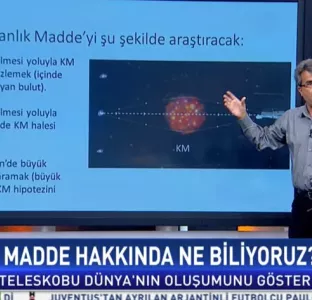
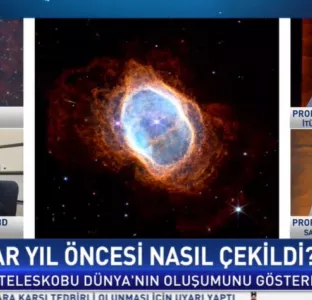

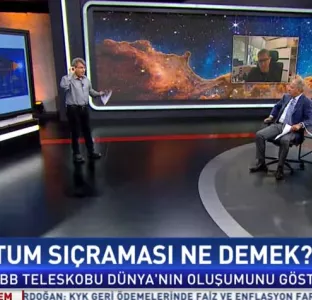
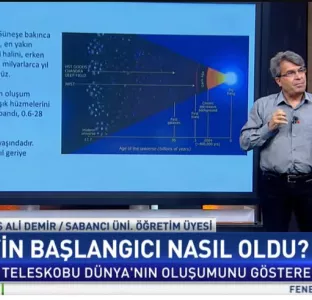
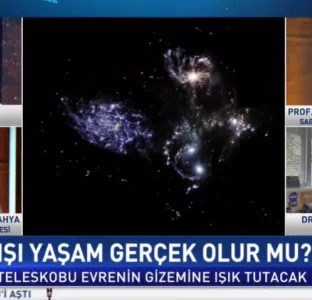
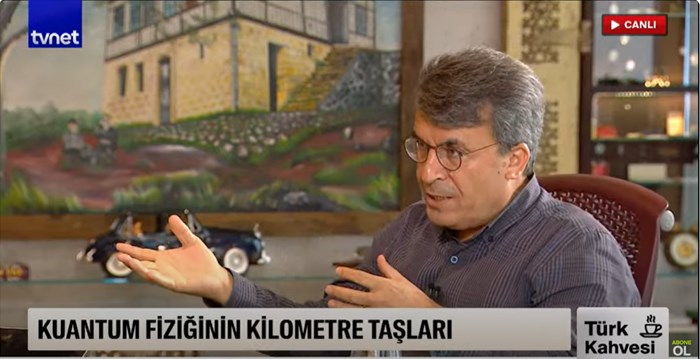
Prof. Demir talking about the Higgs particle on live TV in 2023

Prof. Demir appeared on the TV program "Muhabbet Kralı" hosted by Okan Bayülgen.
Ali Övgün
Professor Durmuş Ali Demir was more than just a supervisor; he was a mentor and a friend. Our collaboration resulted in seven publications in highly regarded journals, and we had several ongoing projects that showcased his passion for pushing the boundaries of physics.
His unwavering support and encouragement extended beyond academics, as he actively helped me participate in workshops and conferences, experiences that shaped my academic path.
Driven by an insatiable intellectual curiosity, Professor Demir wasn't just a physicist; he was a visionary who reveled in tackling fundamental problems in quantum physics. He relentlessly pursued solutions to groundbreaking questions in particle physics and cosmology.
He remained accessible, always available via email or phone whenever his students needed guidance or support. His passing leaves a void, not just in the field of physics but also in the lives of his students who cherished his friendship.
Professor Demir may be gone, but his legacy lives on – in the research we continue, in the lessons learned, and in the inspiration he instilled. We are incredibly proud to have been his students and collaborators.
Professor Demir, we will miss your brilliance, your mentorship, and your friendship. Rest in peace.
Regards,
Ali Övgün
Cyprus
Shahin Mamedov
He was able to present Physics as a property of nature and to explain it in simple words understandable to everyone. I have some e-mail contacts with him and observed his high personal qualities as well. He accepted my invitation to be an invited speaker at the conference organized by us in Baku this summer. Unfortunately, he will not participate in it. I watched his talks on the Internet several times. He was one of the rare theorists, who knew both particle physics and general relativity.
Beyhan Puliçe
I consider it a great honor to have met you many years ago, to have been your student, and to have continued as your collaborator and friend until the last moment.
We met every day in your room at Sabancı University and worked for hours. You were both a mentor and a candid friend. We have done many works together and prepared to do many more.
It will be an honor for me to continue your legacy in this bright path you have opened in the world of physics.
The sincerity of your passion for your work and life has always inspired me. You are always with me, and you always will be, my dearest Hocam.
I will miss you forever and ever.
Beyhan Puliçe
Özer Özdal
Dear Professor, Durmuş Ali Demir was not only an academic figure but also a great role model for us. In every scientific discussion, I have always asked myself how I could possibly be as knowledgeable and passionate as him, given the knowledge and passion I gained from him. He also greatly helped me in establishing connections for my PhD studies in Canada and continued his mentorship. His remarkable contributions to topics that only a few physicists dare to explore have always greatly mesmerised me. He has been a great source of inspiration for us not only scientifically but also personally.
We will keep his teachings and legacy alive in our memories. His contributions to the scientific community and students will never be forgotten. Rest in peace.
Hemza Azri (a former student of Prof. Demir)
I still recall his words "Hemza! Please go ahead and do it, I am sure you can do it..." I remember how I often come up with something interesting once I hear these words from him in the morning.
Several years after my graduation, I wrote to him about the challenges of being a postdoc and the difficulties I face in pursuing an academic career, he kindly wrote to me "I am sorry to hear that you felt bad about the whole process and struggled to publish papers (at the expense of not many citations). It happened to me and will happen. It will happen to you. Please do not lose hope about the future; I am sure you will be a great physicist. You already are. Let us just continue to work on our problems and projects. Don't hesitate a moment, take care, and be happy."
I must say that words alone cannot fully convey the integrity and expertise of Professor Durmus Ali Demir, both as an honest individual and as a competent scientist.
I am deeply saddened by the loss of Durmuş ''hocam'' the person and the physicist.
Reggie Pantig
It is with a heavy heart that I honor the memory of Professor Durmuş Ali Demir, a remarkable collaborator and esteemed figure in theoretical astrophysics. His passion, intellect, and unwavering dedication will be dearly missed. May his legacy continue to inspire future generations of theoretical astrophysicists. Although I have known him for a short while through our online collaboration, I can feel his kind heart and calmness in every situation. I will never forget his encouragement when I experienced uncertainties in my career.
Mariana Frank
His brilliance, breadth of knowledge and sheer ability in physics always motivated and elevated our studies. I also benefitted significantly from supervising some of the students he had previously supervised and mentored at IZTECH, students of the highest quality as physicists and human beings, who consistently kept him in very high regard. They all did him proud.
I also had the pleasure to spend some time at IZTECH and socialize with Durmus, his wife and son. My deepest condolences go first to them, then to the Turkish Physics community, and finally to the international High Energy/Particle Physics community. A huge loss for us all.
Elham Ghorani
The courses I took from him were the best lectures I have ever attended. He was coming to the class without even a single paper or any book. He was coming with only a marker and he used to start from basics and derive everything at the moment in the class. He did this not only for basic courses but also for advanced courses like quantum field theory! And he was so passionate and happy while doing this. His classes was also a journey through the history of science. There is no need to mention about his personality because everyone who met him even once has noticed his kindness, generosity, and passion. May he rest in peace...
Oleg Lebedev
My heartfelt condolences for a great physicist and collaborator.
Keith Olive
I am very saddened to learn of Durmus' passing.
He was a valuable member of our group, and it was a pleasure to collaborate with him.
He brought great excitement to his research which we will never forget.
Maxim Pospelov
I would like to express my condolences to Durmus Demir's family and colleagues.
Durmus and I collaborated in the early 2000s, on a series of projects, when he and I were both postdocs at the University of Minnesota. I will always remember his infectious enthusiasm for science, and very passionate manner in which he pursued a variety of topics in physics. He will be greatly missed!
Ahmadjon Abdujabbarov
Collaboration with Professor Demir was very interesting and useful for all members of the subgroup. We have learnt a lot from him. We will miss his contribution to the Science. I believe that his former students will continue make interesting and useful research in order to tribute his memory. The GR community in Tashkent, Uzbekistan will never forget him! My personal condolences to his family members, friends and colleagues.
Florian Bauer
This lets me feel very sad. I met Durmuş at the DESY and enjoyed very much discussing and collaborating with him. We have lost a great friend and scientist.
Alexander Belyaev
I knew Durmus for more than 20 years ... He was a great person and physicist.
This is very sad news; it is hard to believe what happened…
My deepest condolences to Durmus family and to everybody who knew him…
Paul Langacker
I was very much saddened to learn of Durmus' much too early death. I remember him well from his postdoctoral stay at the University of Pennsylvania, where he was a lively collaborator (along with Mirjam Cvetic, Jose Espinosa, and Lisa Everett) on an important paper showing that an additional neutral gauge boson could solve a serious problem with minimal supersymmetry. Later Durmus, Lisa and I collaborated at a distance on a mechanism for small Dirac neutrino masses in supersymmetry. I always enjoyed interacting with Durmus and will miss him.
Umut Gürsoy
Durmuş was a very active and prolific theoretical physicist who has significantly contributed to particle physics beyond the standard model. He was one of the key figures who represented and kept alive Turkish theoretical physics community in Turkey thanks to his excitement, sharpness, never ending energy and deep insights. We lost him too early. My heartfelt condolences to his family and friends and to the worldwide physics community.
Ernest Ma
I met Durmus Demir in 1998 at Bogazici University where I was giving a seminar. He had traveled some distance to be there to meet me, and we talked a lot about our common interests in various physics topics. I invited him to visit Riverside in 2000 and we wrote 3 papers together, all regarding a new idea that in supersymmetry, a gluino axion is a natural possibility. We kept in touch but did not see each other again until 2020 in Egypt, which was a very pleasant surprise. He was the same as I remembered him, full of enthusiasm and asking penetrating questions as always.
Even though Durmus and I only knew each other briefly, his warmth and friendship will stay with me always.
Sebastian Murk
His passion and curiosity for physics were evident from the very moment he began to speak. He was the kind of person who is always happy to discuss any and all aspects of physics. From the interactions I have had with his students and collaborators it is clear that he was not only a brilliant researcher but also an amazing teacher, mentor, and role model. His passing is a big loss that will be felt by the physics community, his family, his friends, and all of those whom he inspired. I take comfort in the fact that his legacy — both in terms of his scientific vision, as well as his passion and curiosity — will live on through the work of his students.
Yasaman Farzan
…it was very encouraging to meet energetic Durmus who was determined to go back to his homeland and make a difference. After graduation I came back to Iran when Durmus became a young faculty in Izmir. We started collaborating remotely. We worked on phenomenological supergravity which was fashionable back then. We wrote two papers together. Durmus visited us at IPM, Tehran in 2006. I have so many fond memories of this visit.
In 2012, my husband and I were invited by Durmus to visit his institute in Izmir. Impact that he was making on his group was impressive.
He will be remembered by all of us whose life and career has been touched by him. Peace be upon him. It is such a shock to lose such a wonderful person. May God grant his family to endure this great tragedy. My deepest condolences to his family and friends.
Lisa Everett
Like so many of us, I am deeply shocked and saddened by Durmus' sudden passing. Durmus was an exemplary physicist who reveled in challenging himself and pushing the boundaries of our field. He was also a teacher, mentor, and good friend to many people. He was one of my most important mentors and collaborators in my career; our collaborations over the years have been some of my most valued experiences in physics. Durmus had such great enthusiasm and passion for physics, and he was one of the kindest and most generous people I have ever met. This is such a devastating loss for so many of us personally, and for our field as a whole. Durmus' legacy in physics will continue through his work, and through the many people he taught, mentored, and helped during his career. We will never forget him. My deepest condolences to all of Durmus' colleagues, friends, and loved ones, and especially to his immediate family, during this very difficult time.
Shahram Jalalzadeh
I must emphasise that Durmus was not solely a dedicated scientist immersed in his research. Throughout the years, I discovered him to be a compassionate individual with a keen interest in culture, and music, and a strong commitment to democratic principles. His unwavering support extended to those around him, including students, as he always lent a helping hand with any matter, no matter how small. His genuine care and willingness to assist others truly set him apart.
…Recently, we embarked on a collaborative research endeavor, which has yielded very promising results in my estimation. The void left by his passing is immeasurable, affecting not only us, his friends, and colleagues but also the entire physics community. His absence leaves a profound impact that will be deeply felt.
